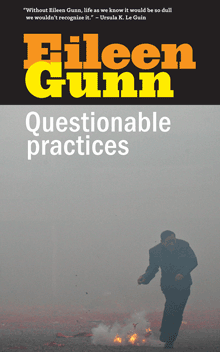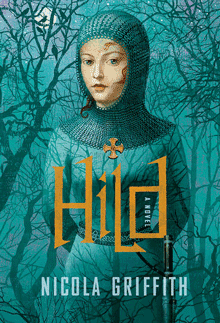Many of you know that I live with an author: my partner and wife Eileen Gunn is a well-respected short story writer, whose first collection, Stable Strategies and Others, was published in 2004 by Tachyon Publications. Not surprisingly, I designed and typeset that book (and ended up doing a good bit of design for Tachyon, sometimes covers, sometimes interiors, over several years). We also developed a visual identity for the book and its marketing campaign – a necessity in today’s publishing world – where I had fun putting the incendiary cover image to work in other contexts.

Now I’ve designed her second collection, Questionable Practices, which will be out in April from Small Beer Press. The interior text design echoes the earlier book, but we gave this one a distinctly different cover design – though one that I think will sit comfortably on a bookshelf next to Stable Strategies. The publisher has just sent out ARCs (Advance Reading Copies) to reviewers.
The cover for Questionable Practices went through three entirely different versions, as these things often do (not counting the innumerable iterations of each still lurking on my hard drive). It’s in the nature of commercial book publishing that the publisher needs a cover image, for publicity and marketing purposes, long before they need a finished book; indeed, often enough the text isn’t finalized until long after a cover image has been widely distributed. When I was working as a typographer at Microsoft Press in the mid-1980s, we used to get outside “designs” from a local studio that simply provided cover sketches and sample pages with typical interior design elements; these were done long before the book was even written. Not only did we have to execute the final covers, but we often had to invent designs for new interior elements that came along as the books were written and edited. Eventually, since we were doing half the design work anyway, we took the interior design in-house.
Eileen’s stories don’t fit into obvious categories; they’ve almost all been published as science fiction, but she refuses to ever repeat herself, and her work rejects easy classification. When I designed the cover for her first collection, I was trying to do something that would stand out both on the general-fiction table and in the science-fiction section of a bookstore. As I discovered, though, few bookstores were willing to shelve copies of the same book in two different sections; it was always one or the other. Today, with online marketing and bookselling, perhaps it’s easier to place a book in multiple categories at the same time. In any case, today a book cover needs to be clear and work well as a little thumbnail image, not just at full size on the physical book.
Naturally, each of the three cover versions for Eileen’s book seemed perfect to me at the time, but in the end the one you see at the left worked best – and will be on the book. As a completely objective and nonpartisan observer, I can say: watch for it.
[Update, Jan. 16: I just sent the book to the printer today. Publication date: March. Typeface: Dolly Pro.]





